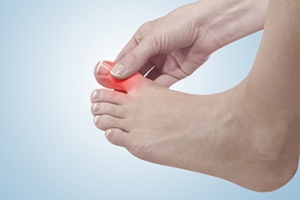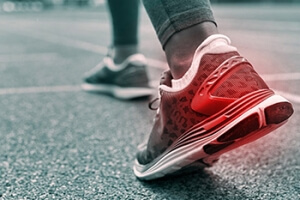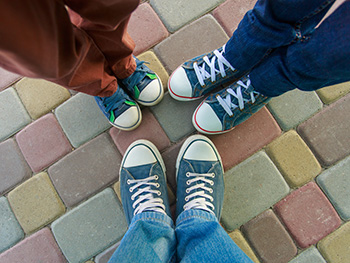
Symptoms and Causes of Sever’s Disease
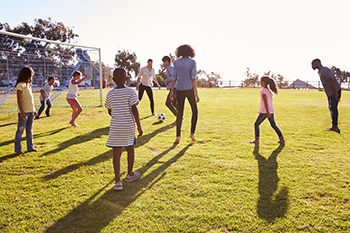
When children experience a growth spurt during puberty there can be an imbalance in the growth rate of their muscles, bones, and tendons. This is termed Sever’s disease, which generally affects children between the ages of 8 and 14. This condition occurs because the muscles and tendons in the heel become tight, pulling on the growth plate (cartilage) in the back of the heel. It is quite common in children who are particularly active in sports with a lot of running and jumping or other strenuous activities, such as gymnastics and dancing. Your child may experience redness or swelling in the back of the heel, stiffness in the feet first thing in the morning, and pain when the heel is squeezed on both sides. You also may notice them limping or walking on their tiptoes. Cutting down on the activities which induce the pain is one way to help alleviate symptoms of Sever’s disease, which may last for a few months. To be on the safe side, however, it is a good idea to introduce your child to a podiatrist who can conduct a full examination and suggest a program of treatment.
Sever's disease often occurs in children and teens. If your child is experiencing foot or ankle pain, see one of our podiatrists from Sayville Foot Care. Our doctors can treat your child’s foot and ankle needs.
Sever’s Disease
Sever’s disease is also known as calcaneal apophysitis, which is a medical condition that causes heel pain I none or both feet. The disease is known to affect children between the ages of 8 and 14.
Sever’s disease occurs when part of the child’s heel known as the growth plate (calcaneal epiphysis) is attached to the Achilles tendon. This area can suffer injury when the muscles and tendons of the growing foot do not keep pace with bone growth. Therefore, the constant pain which one experiences at the back of the heel will make the child unable to put any weight on the heel. The child is then forced to walk on their toes.
Symptoms
Acute pain – Pain associated with Sever’s disease is usually felt in the heel when the child engages in physical activity such as walking, jumping and or running.
Highly active – Children who are very active are among the most susceptible in experiencing Sever’s disease, because of the stress and tension placed on their feet.
If you have any questions, please feel free to contact our office located in Sayville, NY . We offer the newest diagnostic and treatment technologies for all your foot and ankle injuries.
Sever's Disease
Sever’s disease, also known as calcaneal apophysitis is a common bone disorder that occurs during childhood. The disease is defined as an inflammation of the growth plate in the heel. When a child has a growth spurt, his heel bone grows faster than the muscles, tendons, and ligaments in his leg. This disease is a result of overuse. The people who are most likely to be affected by this disease are children who are in a growth spurt, especially boys who are from the ages of 5 to 13 years old. 60% of children with Sever’s disease have both heels involved.
Symptoms of this disease are heel pain that intensifies during running and jumping activities. The pain is typically localized to the posterior part of the heel. Symptoms may be severe, and they can easily interfere with daily activities. Children who play soccer, baseball, and basketball are more likely to develop Sever’s disease.
Your doctor will diagnose your child based on his or her symptoms, x-rays are generally not helpful in diagnosing this disease. Your doctor may examine both heels and ask your child questions about his or her activity level in sports. Your doctor may then use the squeeze test on your child’s heel to see if there is any pain. Nevertheless, some doctors might still use x-rays to rule out any other issues such as fractures, infections, and tumors.
Sever’s disease can be prevented by maintaining good flexibility while your child is growing. Another prevention method is to wear good-quality shoes that have firm support and a shock-absorbent sole. Sever’s disease can be treated by ceasing any activity that causes heel pain. You should apply ice to the injured heel for 20 minutes 3 times a day. Additionally, orthotics should be used for children who have high arches, flat feet, or bowed legs.
If you suspect your child has Sever’s disease, you should make an appointment with your podiatrist to have his or her foot examined. Your doctor may recommend nonsteroidal anti-inflammatory drugs (NSAIDs), such as ibuprofen or naproxen to relieve pain. In more severe cases, your child may need a cast to rest his or her heel. Fortunately, Sever’s disease does not cause long-term foot problems. After treatment, your child should start to feel better within two weeks to two months.
Dealing With a Dislocated Toe
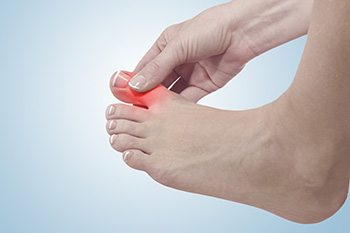
The most common cause of a dislocated toe is direct injury, either bumping into something solid or dropping something heavy on it. You most likely will feel extreme pain at the time of the injury, it will be hard to bend, or even move the toe; and it will swell, become bruised or lose feeling. Sometimes a loose ligament will cause a toe to dislocate, which is extremely painful. Avoid trying to pop the toe into place yourself, as this may cause further injury. The first thing to do is stop further activity, elevate the foot, immobilize it, and apply ice. Next, make an appointment with a podiatrist immediately. An X-ray may be required, followed by manipulating the bones back into place. Followup treatments include strapping the injured toe to the one next to it, alternating ice and heat, undergoing whirlpool treatments, and doing strengthening exercises. A podiatrist can properly diagnose the severity of your toe injury and propose the proper treatment plan for you.
A broken toe can be very painful and lead to complications if not properly fixed. If you have any concerns about your feet, contact one of our podiatrists from Sayville Foot Care. Our doctors will treat your foot and ankle needs.
What to Know About a Broken Toe
Although most people try to avoid foot trauma such as banging, stubbing, or dropping heavy objects on their feet, the unfortunate fact is that it is a common occurrence. Given the fact that toes are positioned in front of the feet, they typically sustain the brunt of such trauma. When trauma occurs to a toe, the result can be a painful break (fracture).
Symptoms of a Broken Toe
- Throbbing pain
- Swelling
- Bruising on the skin and toenail
- The inability to move the toe
- Toe appears crooked or disfigured
- Tingling or numbness in the toe
Generally, it is best to stay off of the injured toe with the affected foot elevated.
Severe toe fractures may be treated with a splint, cast, and in some cases, minor surgery. Due to its position and the pressure it endures with daily activity, future complications can occur if the big toe is not properly treated.
If you have any questions please feel free to contact our office located in Sayville, NY . We offer the newest diagnostic and treatment technologies for all your foot and ankle needs.
What to Know About a Broken Toe
Trauma to the foot, especially the toes, can occur in many ways. Banging them, stubbing them, or dropping something on them are a few different ways this trauma can occur. Given the fact that toes are positioned in front of the feet, they typically sustain the brunt of such trauma. When trauma occurs to a toe, the result can be a painful break or fracture. Another type of trauma that can break a toe is repeated activity that places stress on the toe for prolonged periods of time.
Broken toes can be categorized as either minor or severe fractures. Symptoms of minor toe fractures include throbbing pain, swelling, bruising on the skin and toenail, and the inability to move the toe with ease. Severe toe fractures require medical attention and are indicated when the broken toe appears crooked or disfigured, when there is tingling or numbness in the toe, or when there is an open, bleeding wound present on the toe.
Generally, a minor toe break will heal without long-term complications. However, it is important to discontinue activities that put pressure on the toe. It is best to stay off of the injured toe and immediately get a splint or cast to prevent any more additional movement of the toe bones. You can also immobilize your toe by placing a small cotton ball between the injured toe and the toe beside it. Then, tape the two toes together with medical tape. Swelling can be alleviated by placing an ice pack on the broken toe directly as well as elevating your feet above your head.
Severe toe fractures may be treated with a splint, cast, and in some cases, minor surgery, especially when the big toe has been broken. Due to its position and the pressure the big toe endures with daily activity, future complications can occur if it is not properly treated. Pain associated with minor toe fractures can be managed with over-the-counter pain medications. Prescription pain killers may be necessary for severe toe fractures.
The healing time for a broken toe is approximately four to six weeks. In severe cases where the toe becomes infected or requires surgery, healing time can take up to eight weeks or more. While complications associated with a broken toe are immediately apparent, it is important to note that there are rare cases when additional complications, such as osteoarthritis, can develop over time. You should immediately speak with your podiatrist if you think you have broken your toe due to trauma. They will be able to diagnose the injury and recommend the appropriate treatment options.
Several Differences Between Walking and Running Shoes
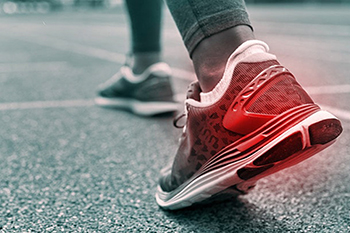 Walking and running are two completely different activities that impact different parts of the feet. Research has shown it is beneficial to wear shoes that can complement different running and walking styles. One of the differences between the two types of shoes has to do with the type of sole. Running shoes have stiffer and sturdier soles than walking shoes. This is helpful in providing the necessary stability while running. Proper walking shoes have a flexible sole, and the heels tend to be heavier than those of running shoes. Additionally, the shoes are made of different materials. Running shoes are made of breathable fabrics, which can help when feet become sweaty. A portion of the shoe that is referred to as the counter can help provide a secure fit. In walking shoes, the heel is tilted, and the toe area is stiff. Please confer with a podiatrist who can provide you with more information about the differences between walking and running shoes.
Walking and running are two completely different activities that impact different parts of the feet. Research has shown it is beneficial to wear shoes that can complement different running and walking styles. One of the differences between the two types of shoes has to do with the type of sole. Running shoes have stiffer and sturdier soles than walking shoes. This is helpful in providing the necessary stability while running. Proper walking shoes have a flexible sole, and the heels tend to be heavier than those of running shoes. Additionally, the shoes are made of different materials. Running shoes are made of breathable fabrics, which can help when feet become sweaty. A portion of the shoe that is referred to as the counter can help provide a secure fit. In walking shoes, the heel is tilted, and the toe area is stiff. Please confer with a podiatrist who can provide you with more information about the differences between walking and running shoes.
For more information about walking shoes versus running shoes, consult with one of our podiatrists from Sayville Foot Care. Our doctors can measure your feet to determine what your needs are and help you find an appropriate pair of footwear.
Foot Health: The Differences between Walking & Running Shoes
There are great ways to stay in shape: running and walking are two great exercises to a healthy lifestyle. It is important to know that running shoes and walking shoes are not interchangeable. There is a key difference on how the feet hit the ground when someone is running or walking. This is why one should be aware that a shoe is designed differently for each activity.
You may be asking yourself what the real differences are between walking and running shoes and the answers may shock you.
Differences
Walking doesn’t involve as much stress or impact on the feet as running does. However, this doesn’t mean that you should be any less prepared. When you’re walking, you land on your heels and have your foot roll forward. This rolling motion requires additional support to the feet.
Flexibility – Walking shoes are designed to have soft, flexible soles. This allows the walker to push off easily with each step.
If you have any questions, please feel free to contact our office located in Sayville, NY . We offer the newest diagnostic and treatment technologies for all your foot care needs.
Walking Shoes vs. Running Shoes
Although walking shoes and running shoes look similar, they have characteristics that make them different from each other. Runners should avoid running in walking shoes and vice versa. It is very important that you wear the proper footwear for the activity you are going to partake in, for you to avoid injury.
If you are looking to buy a new pair of running shoes, there are certain things you should look out for. One of the main components that makes up a good running shoe is flexibility. You should be able to bend and flex the forefoot of the shoe that you are purchasing. If you can bend the entire shoe in half with ease, this is a sign that the shoe does not have enough structure for your feet. Another feature you should look for is a low heel. Certain running shoes have a low heel to support runners who land on the ball of their feet. Lastly, you should look for the fit of the running shoe. You should visit the best running shoe store in your area to have your feet properly sized for the shoes in the store. Usually, the staff will be able to help recommend the best type of running shoe for your needs.
When you are walking, the body’s weight is evenly distributed on the foot. This influences the design of shoes made for walking. If you are looking to buy a pair of walking shoes, there are different features you should look for to determine which pair of shoes is best for you. Walking shoes should be flexible through the ball of the foot to allow for a greater range of motion through the roll of the forefoot. These shoes also should have greater arch support for the foot. If you plan on walking long distances or on hard surfaces, it is best that you wear shoes that have cushioning.
When trying on a new pair of shoes, the heel should fit snugly without slip. You should shop for shoes after a long walk, since your feet tend to swell throughout the day. Many people have one foot that is a different size than the other, so it is best that you have both feet measured when looking for your true size. You should also beware that sizes vary depending on the shoe brand. A certain size in one brand may be a different size in a different brand. Lastly, you should always walk around in shoes that you plan on buying. This will help you determine whether the shoes are comfortable and if they fit well on your feet.
Always look for good shoe construction when shopping for new sneakers. The upper part of the shoe should allow for adjustment through laces or straps. If you need help with shoe sizing or if you need custom orthotics for your feet, you should make an appointment with your podiatrist for assistance. He or she will be more than happy to help you with your shoe sizing needs.
Different Running Paths Will Determine the Type of Running Shoes
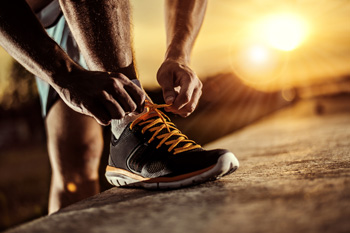 Finding the correct running shoes for you, and your style of running is important because they provide a foundation for your body. The right shoes will fit well from the start, and should not have to be broken in. Most runners find it helpful to be aware of what type of surface they plan to run on. The choices are generally gravel paths or trails, and there are running shoes that are made for both types. Research has shown that the majority of running shoes will last between four to five hundred miles, which equates to three to four months for regular runners. Shoes that are made to run on roads or pavements are made of light and flexible materials, and have smoother soles. Cleats are found on shoes that are made for trails, which can provide a better grip. If you are a runner, or are considering running as a hobby, please check with a podiatrist who can answer any questions you may have about how to choose the pair of running shoes for you.
Finding the correct running shoes for you, and your style of running is important because they provide a foundation for your body. The right shoes will fit well from the start, and should not have to be broken in. Most runners find it helpful to be aware of what type of surface they plan to run on. The choices are generally gravel paths or trails, and there are running shoes that are made for both types. Research has shown that the majority of running shoes will last between four to five hundred miles, which equates to three to four months for regular runners. Shoes that are made to run on roads or pavements are made of light and flexible materials, and have smoother soles. Cleats are found on shoes that are made for trails, which can provide a better grip. If you are a runner, or are considering running as a hobby, please check with a podiatrist who can answer any questions you may have about how to choose the pair of running shoes for you.
You should always make sure your running shoes fit properly in order to avoid injury. For more information, contact one of our podiatrists from Sayville Foot Care. Our doctors can provide the care you need to keep you pain-free and on your feet.
Choosing the Right Running Shoe for Your Foot Type
Improper shoe sizing can cause a myriad of problems for your feet. Shoes that don’t fit you properly can lead to muscular imbalances in your body, which can result in foot, knee, and hip injuries.
Tips for Finding the Right Running Shoe
- Make sure you have a thumb’s width of wiggle room between the end of your longest toe and the front of the shoe.
- There should be little to no slipping at the heel
- Don’t assume your size in one shoe brand will be your size in another
- Do not lace up your shoes too tightly
- Walk around in the store with your new shoes before you buy them
If you have any questions please feel free to contact our our office located in Sayville, NY . We offer the newest diagnostic and treatment technologies for all your foot and ankle needs.
Choosing the Right Running Shoe
Choosing the right running shoes for you is an important part of running. A good pair of running shoes will make the running experience more enjoyable for you and prevent potential injury.
Poorly-fitted shoes can increase the risk of injury in runners substantially. Common injuries from running with poor quality shoes include shin splints, sprained ankles, Achilles tendinitis, stress fractures, plantar fasciitis and more. This is due to the fact that bad shoes do not provide proper foot support, can increase pronation (how much the foot rolls when hitting the ground), have little to no cushioning, do not allow the feet to breath, and do not provide enough flex and rigidity in the right parts.
When looking for running shoes, first, determine where you will be running. If you are a trail runner, then pick trail shoes. If you run on concrete and asphalt, then regular running shoes are the best choice. When trying on shoes, its best to go at the end of the day as feet grow during the day and shrink after a night of sleep. Shoes should be more rigid towards the back of the foot while being more flexible up where the toes are. The toe box should provide enough room for the toes to move freely. The overall fit should be snug, not too tight but not too loose. A good pair of running shoes should also provide enough arch support for your foot type. If you experience overpronation or under-pronation while running, try to find a pair of shoes that will help correct this with different sole patterns. Finally, try to find a pair of shoes that allow the feet to breathe like nylon mesh or synthetic leather.
Don’t forget about the socks either. Socks that hold too much moisture can lead to athlete’s foot. Socks should be breathable so that your feet can air out and breathe. Synthetic socks wick away moisture like sweat. If you tend to run a lot, having a second pair of shoes that you can wear while you let the first pair air out is smart. Just don’t forget to replace your shoes after about every 300 to 500 miles.
Before you start running, it is advised to see a podiatrist to see if running is right for you. They can also offer good advice on how to run and what to look for in a pair of running shoes. If you have flat feet or poorly supported ones, they can also offer custom-made orthotics that will help give your feet the support they need.
Shoes Can Tell the Story of Your Feet
Many foot problems can be solved by taking a look at the shoes you wear, whether it be running shoes, flip-flops, dress shoes or bedroom slippers. For instance, plantar fasciitis, one of the most common causes of heel pain, can be the result of doing pounding exercises in shoes that lack proper cushioning and padding. Similarly, metatarsalgia and Morton’s neuroma, resulting in pain in the ball of the foot, can be directly linked to shoving your feet into tight high-heeled shoes with pointy toes and then walking in them or standing for long periods of time. Flip-flops can be bearers of fatigue, caused by lack of arch support and cushioning in the heel. Any shoes with thin flat leather soles and uppers may be the root of calluses and corns that turn into painful areas on the toes and soles of your feet. Taking long walks, hiking, or running in shoes that are not specifically made for the activity, can result in painful blisters. A good way to find out which shoes are best for your feet and your lifestyle is to consult a podiatrist for guidance in seeking proper footwear.
Finding a properly-fitting shoe is important in reducing injuries and preventing foot problems. For more information about treatment, contact one of our podiatrists from Sayville Foot Care. Our doctors will treat your foot and ankle needs.
Proper Shoe Fitting
A common concern when it comes to foot health, having properly fitted shoes can help prevent injuries to the foot. Out feet affect our posture and gait, which in turn affects the biomechanics and overall bodily structure. With 33 joints, 26 bones, and over 100 ligaments, the potential for serious injury is much greater than one realizes. Although the feet cease growth in adulthood, they still change shape as they mature. Here are some factors to consider when it comes to investing in proper fitting shoes:
- Be sure the shoes fit correctly right away
- Ensure the ball of your foot fits comfortably in the widest portion of the shoes
- Even though they may look fashionable, improper fitting shoes can either create adverse conditions or exacerbate existing ones you may already have
- Walk along a carpeted surface to ensure the shoes comfortably fit during normal activity
Keeping in mind how shoes fit the biomechanics of your body, properly-fitting shoes are vitally important. Fortunately, it is not difficult to acquire footwear that fits correctly. Be sure to wear shoes that support the overall structure of your body. Do your feet a favor and invest in several pairs of well-fitted shoes today.
If you have any questions please feel free to contact our office located in Sayville, NY . We offer the newest diagnostic and treatment technologies for all your foot and ankle needs.



